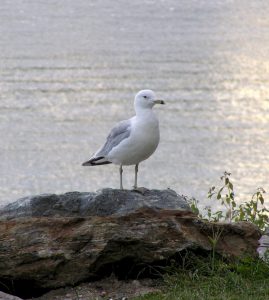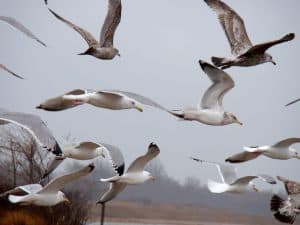Share this article
From Pristine to Polluted and Back — from The Wildlife Professional
The waters of Maine’s Lake Auburn were renowned for being pristine. Surrounded by fields, forests and the grassy campus of Central Maine Community College, the 2,260-acre lake above the towns of Auburn and Lewistown was so clean, it provided drinking water to the two towns without having to be filtered. It was a popular summer spot for boating, fishing and kayaking, but officials maintained a strict “no body contact” rule to keep potential contamination from human bacteria and viruses to a minimum and protect the 45,000 residents who relied on the water to fill their drinking glasses and bathtubs. Activities such as swimming and even ice fishing were forbidden.
Lake Auburn is one of only 60 surface water sources in the United States, and one of just nine in Maine, permitted to supply water without filtration, due to its water quality and ongoing watershed protection. But that distinction was threatened about a decade ago.
A new group of visitors suddenly showed up and they were putting the lake’s renowned water quality in jeopardy. Gulls had arrived by the hundreds. In 2004, sightings of these birds at the lake were on the rise. By the fall of 2005, more than 2,000 gulls of various species had besieged the lake. Many appeared to be habituated to the area. With these gulls came guano.
Time for action

Ring-billed gulls are the most-often encountered species on Lake Auburn. Their population has grown rapidly in Maine since the late 20th century. ©Ben Nugent
To prevent drinking water contamination, the U.S. Environmental Protection Agency (EPA) recommends managing birds and other wildlife. By EPA standards, no more than 10 percent of daily water samples taken from Lake Auburn could exceed 20 fecal colonies per 100 milliliters in a six-month running average. If the number of fecal colonies exceeded EPA standards, the filtration waiver could be revoked. This filtration waiver saved the two cities as much as $40 million — the cost of building a filtration plant — and $1.5 million in annual operational costs.
In October, November, and December 2004, the mean fecal count was 18.24 fecal colonies per 100 milliliters. In the latter two months, fecal colonies exceeded EPA standards. Officials with the Auburn and Lewistown water districts realized they needed to take action. They requested assistance from the U.S. Department of Agriculture’s Wildlife Services in November 2005 to help them do something about the gulls.
Birds such as gulls and geese are the most common and significant source of fecal contamination in open reservoirs, the EPA says (US EPA 2001). Gull feces have been implicated in accelerated nutrient loading of aquatic systems (Portnoy 1990), which could have serious implications for municipal drinking water sources.
Research has shown that gulls carry various species of bacteria such as Bacillus sp., Clostridium sp., Campylobacter spp., Escherichia coli, Listeria spp., and Salmonella spp. (Fenlon 1981, Norton 1986, Quessey and Messier 1992). The once pristine Lake Auburn now tested positive for Campylobacter lari (Camp, Dresser, & McKee Inc. 2005), which can cause human enteritis and severe abdominal pain.
Fireworks, lights and lasers
Primarily, three species of gulls had appeared at Lake Auburn: ring-billed gulls (Larus delawarensis), herring gulls (Larus argentatus), and greater black-backed gulls (Larus marinus). Not surprisingly, the ring-billed gull was the species most often encountered on the lake. Its population has experienced rapid growth in Maine since the late 20th century (Greenlaw and Sheehan 2003).

Herring gulls were a common site at Lake Auburn, where flocks of gulls numbering 2,000 birds were common before the hazing operations began. ©USDA Wildlife Services
Why did such large numbers of gulls congregate here? Gulls were using the large lake for loafing and roosting because of its close proximity to reliable food sources and its location within an important migration corridor, the Androscoggin River. Proximity to the coast enabled easy travel to forage or loaf. Also attractive was the fact that Lake Auburn is the last water in the region to freeze every year. Even though no known gull nesting sites were in the area, a large gull presence persisted throughout the year.
Wildlife Services experts evaluated the situation and initiated an integrated gull damage management program. A variety of non-lethal management methods were used to disperse gulls off the lake, including boats, pyrotechnics, avian dissuader lasers and strobe lights. Wildlife Services and its city partners also educated the public about the problems associated with feeding gulls. Some lethal removal (shooting) was necessary to reinforce the non-lethal methods.
Wildlife Service biologists spent three hours every morning and three more hours every evening harassing the gulls. Over time, the number of gulls decreased, and so did the bacteria levels in the water. Within several weeks, gull numbers were reduced to as few as five per day. By December when the lake froze over and the threat from the gulls had ended for the year, water experts and biologists were relieved. The mean fecal count had dropped by 51.5 percent and Lake Auburn’s water quality once again met state and federal standards.
In spring 2006, as the ice melted from the lake, the Wildlife Services team returned to monitor the gull numbers. Throughout the warmer months, team members kept a regular schedule of gull harassment. By the end of the year, the lake saw a 93 percent reduction in fecal contamination from 2004 levels.
Teams have returned ever since, conducting steady — but slightly less rigorous — dispersal efforts from the time the ice melts to the time the lake freezes. For three hours a day, five days a week, gull harassment teams remain at work. In 2015, gull presence and bacteria levels on Lake Auburn were the second lowest they had been since the management efforts began. This correlation between coliform bacteria levels and gull presence has been observed each year that management has been conducted.
The annual integrated gull damage management program came at a small cost, equivalent to about one-tenth of the cost of operating a filtration plant for one year. Today, gulls still use the lake throughout the year but in far fewer numbers than in previous years.
Integration and cooperation
An important outcome of the Lake Auburn gull management program was the ability to alter gull behavior on a large scale through an integrated approach in which the lethal option only affected a very small part of the area’s gull population. Of the 91,000 gull encounters over the decade, 97 percent were dispersed. Lethal take — only 3 percent of total encounters — averages less than 300 gulls annually, with two-thirds of those being ring-billed gulls.

Wildlife Specialist William White performs a boating patrol at Lake Auburn. Specialists conducted patrols three hours a day, five days a week during ice-free months. ©USDA Wildlife Services
Due to the program, gulls began using other local lakes and ponds as alternate roosting sites. On several occasions, Wildlife Services observed over 3,000 gulls roosting at one nearby pond that became a favored alternate roosting site. Initially, some local residents expressed concerns about water quality at the new gull roosting sites. However, regular water testing revealed the water was still safe for recreational use, and these new roosting sites were not drinking water sources.
The Lake Auburn project has taught some important lessons. Large flocks of gulls can suddenly begin using a sensitive area, such as a drinking water source, and quickly pose a serious threat to human health and safety. A regularly scheduled, integrated harassment program can alter gull behavior, but it must be maintained for the long-term. Gulls will quickly return to a preferred area once harassment stops.
Lastly, this effort is a good example of how people from different organizations and agencies can work together to successfully manage conflicts between wildlife and people and protect important human resources.
Ben Nugent is a wildlife biologist with USDA’s Wildlife Services in Augusta, Maine.
Header Image: Lake Auburn provides unfiltered drinking water to two communities in Maine. By ice-over in 2006, USDA Wildlife Services operations during the prior six months had dropped the bacterial count by 80 percent compared to 2004. Mean fecal counts have been kept at a level that allows an EPA waiver. ©Ben Nugent









